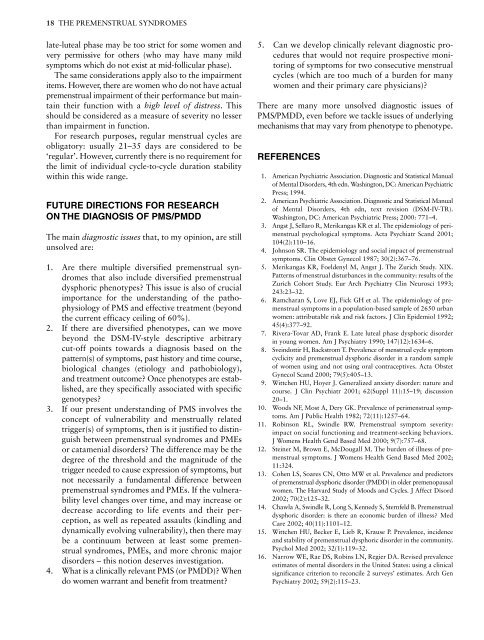Premenstrual Syndromes : PMS and PMDD - Rutuja :: The site ...
Premenstrual Syndromes : PMS and PMDD - Rutuja :: The site ...
Premenstrual Syndromes : PMS and PMDD - Rutuja :: The site ...
Create successful ePaper yourself
Turn your PDF publications into a flip-book with our unique Google optimized e-Paper software.
18 THE PREMENSTRUAL SYNDROMES<br />
late-luteal phase may be too strict for some women <strong>and</strong><br />
very permissive for others (who may have many mild<br />
symptoms which do not exist at mid-follicular phase).<br />
<strong>The</strong> same considerations apply also to the impairment<br />
items. However, there are women who do not have actual<br />
premenstrual impairment of their performance but maintain<br />
their function with a high level of distress. This<br />
should be considered as a measure of severity no lesser<br />
than impairment in function.<br />
For research purposes, regular menstrual cycles are<br />
obligatory: usually 21–35 days are considered to be<br />
‘regular’. However, currently there is no requirement for<br />
the limit of individual cycle-to-cycle duration stability<br />
within this wide range.<br />
FUTURE DIRECTIONS FOR RESEARCH<br />
ON THE DIAGNOSIS OF <strong>PMS</strong>/<strong>PMDD</strong><br />
<strong>The</strong> main diagnostic issues that, to my opinion, are still<br />
unsolved are:<br />
1. Are there multiple diversified premenstrual syndromes<br />
that also include diversified premenstrual<br />
dysphoric phenotypes? This issue is also of crucial<br />
importance for the underst<strong>and</strong>ing of the pathophysiology<br />
of <strong>PMS</strong> <strong>and</strong> effective treatment (beyond<br />
the current efficacy ceiling of 60%).<br />
2. If there are diversified phenotypes, can we move<br />
beyond the DSM-IV-style descriptive arbitrary<br />
cut-off points towards a diagnosis based on the<br />
pattern(s) of symptoms, past history <strong>and</strong> time course,<br />
biological changes (etiology <strong>and</strong> pathobiology),<br />
<strong>and</strong> treatment outcome? Once phenotypes are established,<br />
are they specifically associated with specific<br />
genotypes?<br />
3. If our present underst<strong>and</strong>ing of <strong>PMS</strong> involves the<br />
concept of vulnerability <strong>and</strong> menstrually related<br />
trigger(s) of symptoms, then is it justified to distinguish<br />
between premenstrual syndromes <strong>and</strong> PMEs<br />
or catamenial disorders? <strong>The</strong> difference may be the<br />
degree of the threshold <strong>and</strong> the magnitude of the<br />
trigger needed to cause expression of symptoms, but<br />
not necessarily a fundamental difference between<br />
premenstrual syndromes <strong>and</strong> PMEs. If the vulnerability<br />
level changes over time, <strong>and</strong> may increase or<br />
decrease according to life events <strong>and</strong> their perception,<br />
as well as repeated assaults (kindling <strong>and</strong><br />
dynamically evolving vulnerability), then there may<br />
be a continuum between at least some premenstrual<br />
syndromes, PMEs, <strong>and</strong> more chronic major<br />
disorders – this notion deserves investigation.<br />
4. What is a clinically relevant <strong>PMS</strong> (or <strong>PMDD</strong>)? When<br />
do women warrant <strong>and</strong> benefit from treatment?<br />
5. Can we develop clinically relevant diagnostic procedures<br />
that would not require prospective monitoring<br />
of symptoms for two consecutive menstrual<br />
cycles (which are too much of a burden for many<br />
women <strong>and</strong> their primary care physicians)?<br />
<strong>The</strong>re are many more unsolved diagnostic issues of<br />
<strong>PMS</strong>/<strong>PMDD</strong>, even before we tackle issues of underlying<br />
mechanisms that may vary from phenotype to phenotype.<br />
REFERENCES<br />
1. American Psychiatric Association. Diagnostic <strong>and</strong> Statistical Manual<br />
of Mental Disorders, 4th edn. Washington, DC: American Psychiatric<br />
Press; 1994.<br />
2. American Psychiatric Association. Diagnostic <strong>and</strong> Statistical Manual<br />
of Mental Disorders, 4th edn, text revision (DSM-IV-TR).<br />
Washington, DC: American Psychiatric Press; 2000: 771–4.<br />
3. Angst J, Sellaro R, Merikangas KR et al. <strong>The</strong> epidemiology of perimenstrual<br />
psychological symptoms. Acta Psychiatr Sc<strong>and</strong> 2001;<br />
104(2):110–16.<br />
4. Johnson SR. <strong>The</strong> epidemiology <strong>and</strong> social impact of premenstrual<br />
symptoms. Clin Obstet Gynecol 1987; 30(2):367–76.<br />
5. Merikangas KR, Foeldenyl M, Angst J. <strong>The</strong> Zurich Study. XIX.<br />
Patterns of menstrual disturbances in the community: results of the<br />
Zurich Cohort Study. Eur Arch Psychiatry Clin Neurosci 1993;<br />
243:23–32.<br />
6. Ramcharan S, Love EJ, Fick GH et al. <strong>The</strong> epidemiology of premenstrual<br />
symptoms in a population-based sample of 2650 urban<br />
women: attributable risk <strong>and</strong> risk factors. J Clin Epidemiol 1992;<br />
45(4):377–92.<br />
7. Rivera-Tovar AD, Frank E. Late luteal phase dysphoric disorder<br />
in young women. Am J Psychiatry 1990; 147(12):1634–6.<br />
8. Sveindottir H, Backstrom T. Prevalence of menstrual cycle symptom<br />
cyclicity <strong>and</strong> premenstrual dysphoric disorder in a r<strong>and</strong>om sample<br />
of women using <strong>and</strong> not using oral contraceptives. Acta Obstet<br />
Gynecol Sc<strong>and</strong> 2000; 79(5):405–13.<br />
9. Wittchen HU, Hoyer J. Generalized anxiety disorder: nature <strong>and</strong><br />
course. J Clin Psychiatr 2001; 62(Suppl 11):15–19; discussion<br />
20–1.<br />
10. Woods NF, Most A, Dery GK. Prevalence of perimenstrual symptoms.<br />
Am J Public Health 1982; 72(11):1257–64.<br />
11. Robinson RL, Swindle RW. <strong>Premenstrual</strong> symptom severity:<br />
impact on social functioning <strong>and</strong> treatment-seeking behaviors.<br />
J Womens Health Gend Based Med 2000; 9(7):757–68.<br />
12. Steiner M, Brown E, McDougall M. <strong>The</strong> burden of illness of premenstrual<br />
symptoms. J Womens Health Gend Based Med 2002;<br />
11:324.<br />
13. Cohen LS, Soares CN, Otto MW et al. Prevalence <strong>and</strong> predictors<br />
of premenstrual dysphoric disorder (<strong>PMDD</strong>) in older premenopausal<br />
women. <strong>The</strong> Harvard Study of Moods <strong>and</strong> Cycles. J Affect Disord<br />
2002; 70(2):125–32.<br />
14. Chawla A, Swindle R, Long S, Kennedy S, Sternfeld B. <strong>Premenstrual</strong><br />
dysphoric disorder: is there an economic burden of illness? Med<br />
Care 2002; 40(11):1101–12.<br />
15. Wittchen HU, Becker E, Lieb R, Krause P. Prevalence, incidence<br />
<strong>and</strong> stability of premenstrual dysphoric disorder in the community.<br />
Psychol Med 2002; 32(1):119–32.<br />
16. Narrow WE, Rae DS, Robins LN, Regier DA. Revised prevalence<br />
estimates of mental disorders in the United States: using a clinical<br />
significance criterion to reconcile 2 surveys’ estimates. Arch Gen<br />
Psychiatry 2002; 59(2):115–23.


